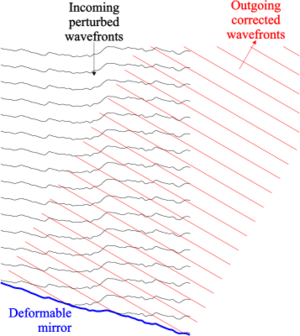Adaptive optics facts for kids
Adaptive optics is a technology to improve the performance of optical systems by reducing the effects of rapidly changing optical distortion (or deformation). It is commonly used on astronomical telescopes to remove the effects of atmospheric distortion, or astronomical seeing.
Adaptive optical works by measuring the distortion and rapidly compensating for it either using deformable mirrors or material with variable refractive properties. While the technique was theoretically understood for some time, it was only advances in computer technology during the 1990s that finally made the technique practical.
Adaptive optics should not be confused with active optics, which works on a longer timescale to correct the primary mirror geometry itself. The simplest form of adaptive optics is tip-tilt correction, which corresponds to correction of the tilts of the wavefront in two dimensions (equal to correction of the position offsets for the image). This is performed using a rapidly moving tip-tilt mirror which makes small rotations around two of its axes.
A significant fraction of the aberration introduced by the atmosphere can be removed in this way. Tip-tilt mirrors are widely used in night time and solar telescopes, to correct the aberration introduced by Earth's atmosphere on the light path and improve image quality over what would be possible according to the atmospheric seeing.
Tip-tilt mirrors are effectively segmented adaptive optics mirrors having only one segment which can tip and tilt, rather than having an array of multiple segments which can tip and tilt independently.
Images for kids
-
Astronomers at the Very Large Telescope site in Chile use adaptive optics.
-
A laser beam directed toward the centre of the Milky Way. This laser beam can then be used as a guide star for the AO.
See also
 In Spanish: Óptica adaptativa para niños
In Spanish: Óptica adaptativa para niños








